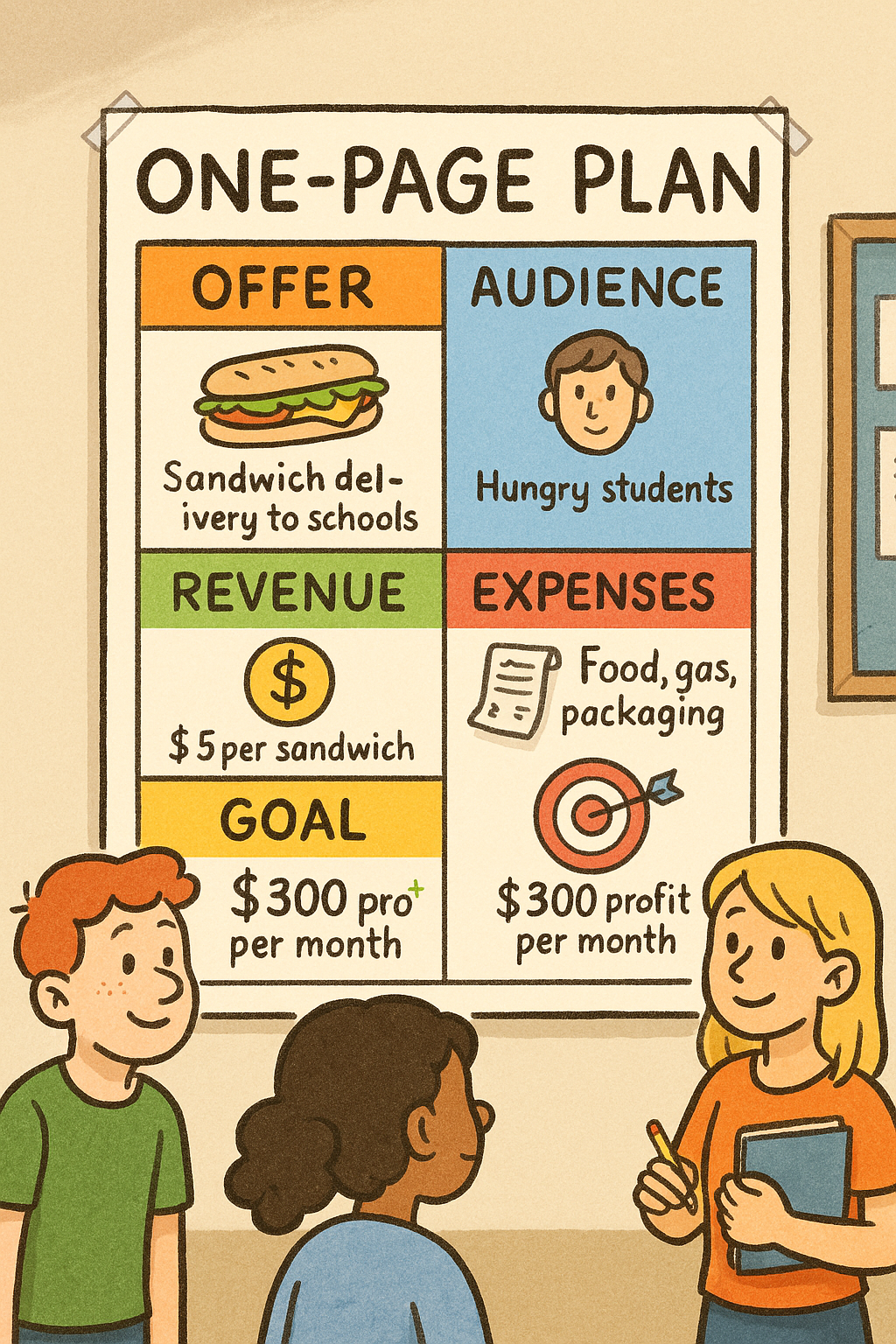🧩 Week 3 – Simple Business Plan
You already have an idea and know who it’s for.
Now it’s time to make it real — by planning how it actually works.
Think of a business plan not as a boring document, but as a map of your idea:
where it starts, who it helps, how it earns, and how it grows.
🗺️ Step 1 – What Do You Offer?
The first question of every business:
“What exactly am I offering, and why would someone care?”
Keep it short.
Imagine you’re explaining to a friend between classes.
Example:
“QuickLunch helps students pre-order school meals to skip waiting lines.”
That’s it — one line that says:
- what you do,
- for whom,
- and what problem it solves.

The best ideas are easy to explain. If your friend gets it in 10 seconds, you’re on the right track.
👥 Step 2 – Who Are Your Customers?
Every plan needs a clear audience.
You already explored it in Market Research — now write it down.
| Question | Example Answer |
|---|---|
| Who are they? | Students aged 14–18 |
| Where do they spend time? | School cafeteria, Instagram |
| What do they want? | Save time at lunch |
| What do they dislike? | Long lines, slow service |
Keep your answers short — this is your Customer Snapshot.
💰 Step 3 – How Will You Earn Money?
Let’s demystify “business models”.
It’s just how money flows in and out.
Here are 3 common examples:
- Direct Sales – you sell something (snacks, art, clothes).
- Subscription – people pay regularly (study app, tutoring).
- Commission – you connect buyers & sellers, and take a small cut.
Pick one that fits your idea.
Example:
QuickLunch earns a small fee from each meal pre-ordered.

Business models are just flows — think of money moving through your idea like water through a pipe.
💸 Step 4 – Know Your Costs
Every idea costs something — time, materials, or even attention.
| Type | Example | Estimated Cost |
|---|---|---|
| Materials | Cups, napkins, lemons | $15 |
| Marketing | Posters, flyers | $5 |
| Tools | Online form builder | Free (trial) |
That’s already a mini cost table!
And once you know your expenses, you can estimate your profit.
🧮 Formula:
Profit = Revenue – Costs
If your lemonade stand sells $40 and spends $20,
your profit is $20. That’s half your revenue — great start!
📊 Step 5 – Visualize It All Together
A simple business plan can fit on one page.
| Section | Your Answer |
|---|---|
| Idea | QuickLunch – pre-order school meals |
| Problem | Long lunch lines |
| Solution | App to order in advance |
| Target Audience | Students, 14–18 |
| Revenue Model | Fee per meal |
| Costs | Printing flyers, small app hosting |
| Profit Goal | $20/month in first test |
Looks simple, right?
But that’s already what real founders do in early stages.

A one-page plan helps you see the big picture — and makes your idea easier to explain to others.
🧠 Step 6 – Real Example: “SnackBot”
- Problem: Students forget snacks for study sessions.
- Idea: A vending robot inside the library.
- Customers: Students staying late after school.
- Revenue: $1 profit per snack sold.
- Costs: Maintenance, restocking, payment system.
- Result: 100 snacks/week × $1 = $100 profit potential.
When you see numbers, your idea becomes real.
That’s when you start to think like a founder.
✅ Your Challenge
- Fill your own one-page plan (you can use our template →).
- Check your idea’s logic — does every piece connect?
- Share it with a friend and ask: “Does this make sense?”
Your goal: clarity over perfection.
🧭 Coming Next
In Week 4, you’ll learn to pitch your business —
how to tell your story confidently and answer tough questions.
📝 Try this today
Describe your product or service in one sentence. What problem does it solve and for whom?
Decide your pricing model — how much will you charge, or how will you make money?
List your 3 biggest costs (materials, time, or marketing).
Use a simple formula: Profit = Revenue – Costs. Try estimating your first month!
Lesson Progress
Module: entrepreneurship · +0% upon completion